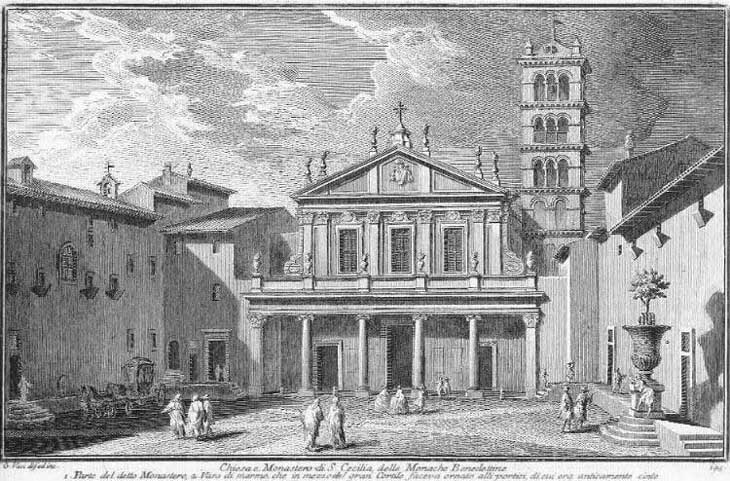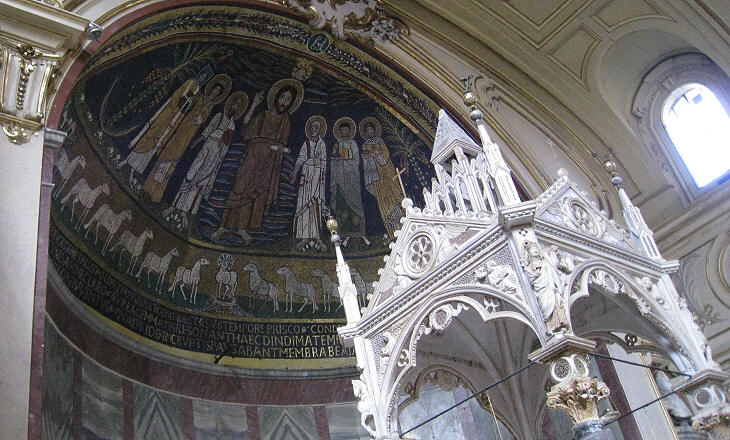  What's New! Detailed Sitemap All images © by Roberto Piperno, owner of the domain. Write to romapip@quipo.it. Text edited by Rosamie Moore. Page revised in March 2010. | Chiesa e Monastero di S. Cecilia (Book 8) (Map C3) (Day 6) (View C10) (Rione Trastevere)
In this page:
On November 22, 1786, Feast of St. Cecilia J. W. Goethe wrote in his diary: "It would take pages to describe the decorations of this church, which was packed with people. One could not see a stone of the structure. The columns were covered with red velvet wound around with ribbons of gold lace, the capitals with embroidered velvet conforming more or less to their shape - so too, with the cornices and pillars. All the intervening wall space was clothed in brightly coloured hangings, so that the whole church seemed to be one enormous mosaic. More than two hundred candles were burning behind and at the sides of the high altar, so that one whole wall was lined with candles, and the nave was fully illuminated. Facing the high altar, two stands, also covered with velvet had been erected under the organ loft. The singers stood on one: the orchestra, which never stopped playing, on the other. Just as there are concertos for violins or other instruments, here they perform concertos for voices: one voice - the soprano for instance - predominates and sings a solo while, from time to time, the choir joins in and accompanies it always supported, of course, by the full orchestra. The effect is wonderful." (Italian Journey - Translation by W. H. Auden and Elizabeth Mayer - Collins 1962). The Benedictine nuns of S. Cecilia often belonged to the wealthiest Roman families and they could afford the decoration described by Goethe; in addition being the titular of S. Cecilia was regarded as a high honour by the cardinals and they supported the cost of the ceremonies for the saint's feast. The view is taken from the green dot in the 1748 map below. In the description below the plate Vasi made reference to: 1) Part of the Monastery; 2) Vase which once stood at the centre of the courtyard. The map shows also 3) Church of S. Cecilia; 4) Entrance to the courtyard; 5) Casa di Ettore Fieramosca; 6) Palazzo Castellani.
In 1929 the beautiful vase with the shape of a cantharus, the ancient drinking cup, was placed at the centre of the courtyard; this is the only change from Vasi's time. Statue of S. Cecilia
According to a late Vth century account St. Cecilia was a Christian martyr who bequeathed all her possessions to the Church, including the house which gave origin to the basilica dedicated to her; the devotion to this saint was greatly increased in the year 1600 when Paolo Emilio Sfondrati, titular cardinal of S. Cecilia ordered the opening of her tomb. The event was attended by many witnesses including sculptor Stefano Maderno who portrayed the recumbent body of St. Cecilia as he saw it in a very evocative statue.
The association of St. Cecilia with music is due to a sentence in the account of her life: in describing her wedding with a pagan man (whom she converted that same night) the author wrote: cantantibus organis, Caecilia in corde suo soli Domino decantabat (while the organs were singing, only Cecilia in her heart was praising the Lord); the words in corde suo (in her heart) were dropped from the text and Cecilia became the patron saint of music and an organ became her symbol (the image used as background for this page shows a detail of the decoration of the church).
The first church was built modifying some Roman houses; Pope Paschal I (817-24) built an entirely new church above the previous one also because the level of the ground had risen owing to floods; notwithstanding the many changes which have occurred in the following centuries, the interior retains the original shape of the basilica. The porch and the bell tower were built towards the end of the XIIth century and the interior was decorated with a Cosmati floor. In 1724 Cardinal Francesco Acquaviva promoted a major renovation of the church by a) modifying the fašade above the portico; b) removing the Cosmati pavement; c) changing the ceiling and d) adding an elaborate stucco decoration; finally in 1823 the ancient columns which separated the main nave from the two smaller ones were incorporated into pillars. The overall result is harmonious, but the interior resembles the hall of a royal palace, rather than a site for prayer. You may wish to see the church in a 1588 Guide to Rome.
Towards the end of the XIIIth century Pope Nicholas IV embellished S. Cecilia with two masterpieces: a ciborium by Arnolfo da Cambio which, notwithstanding all the changes, no one dared to remove and a large fresco by Pietro Cavallini portraying the Last Judgement on the rear fašade; the fresco was partially damaged when the rear fašade was modified to make room for a choir for the nuns: it can be seen by asking permission at the nunnery (you may wish to see it in this external link).
Several titular cardinals of S. Cecilia chose to be buried in the church: among them Cardinal Adam of Easton, a village near Norfolk; he had a pretty troubled life; he was made a cardinal by Pope Urban VI in 1381, but in 1385 he was arrested with five other cardinals and charged with plotting against the pope; he was deprived of his title, but unlike his fellows he was not executed, because the pope did not want to offend King Richard II; Cardinal Adam was restored to his role by Pope Boniface IX who assigned him S. Cecilia; in the meantime relations between Cardinal Adam and King Richard deteriorated and the cardinal chose never to return to England; he ordered however that his funerary monument in S. Cecilia should be decorated with his king's coat of arms.
In 1742 Cardinal Troiano Acquaviva, a relative of Cardinal Francesco Acquaviva, built a new entrance (perhaps designed by Ferdinando Fuga) to the courtyard of S. Cecilia. Cardinal Acquaviva did not hesitate to place a gigantic coat of arms above the entrance; as a matter of fact he was a very influential cardinal who was also the Ambassador of Spain to the Papal State; in this role during the 1740 conclave he vetoed the appointment of Cardinal Pier Marcellino Corradini, thus paving the way to the election of Pope Benedict XIV. Another titular cardinal of S. Cecilia, Cardinal Mariano Rampolla del Tindaro, was involved in a veto during a conclave: in 1903 Emperor Franz Joseph of Austria vetoed his appointment to succeed Pope Leo XIII to whom Cardinal Rampolla had been the Secretary of State for fifteen years. Casa di Ettore Fieramosca
This part of Trastevere was heavily populated in the Middle Ages when the river harbour of Rome
was moved here from Testaccio.
During the Renaissance and the following centuries the area lost its importance and this explains why it retains so many medieval houses.
A fine example of a medieval fortified house stands opposite to S. Cecilia. It is named after Ettore Fieramosca, an Italian knight
who in 1503 led a team of 13 Italian knights against a similar French team in a tournament in Barletta (near Bari). The building dates back to the XIIIth century and it had a small porch supported by ancient columns.
The Castellani were a minor noble family of Trastevere, where they financed some maintenance works at
S. Benedetto in Piscinula; their small palace was pulled down in the late XIXth century when the river bed was enlarged. Two reliefs with their heraldic symbols (lozenges and a boar's head) were walled in nearby Palazzo Nunes, a XVIIth century building which was enlarged and modified in the XIXth century.
Next plate in Book 8: Chiesa e Monastero di S. Giuseppe Next step in Day 6 itinerary: S. Giovanni Battista dei Genovesi |











